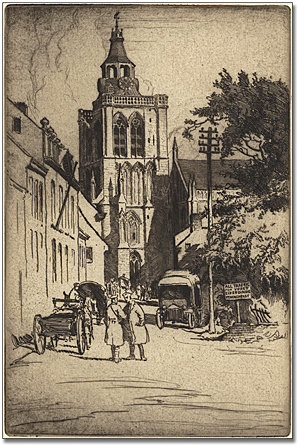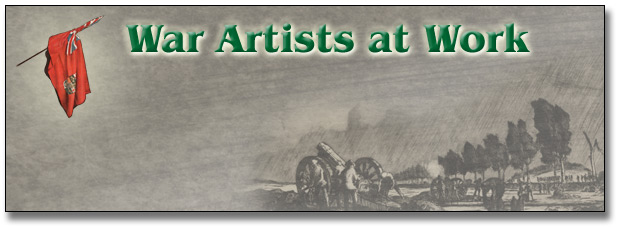
The war artists followed the Canadian army as it made its way from one battle to another. But they were often no more than onlookers. They lived far behind the lines and generally had a batman (aide), a car and a driver.
Several artists complained of the boredom and some drifted to Paris and other towns to find alternative subjects.
|
British
Army & Navy Leave Club, Paris |
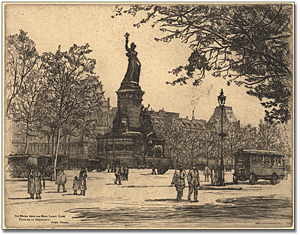
Click to see a larger image (219K)
British Army and Navy Leave
Club Paris, France, 1917
Caroline Armington
Reference Code: C 334-1-1-0-1
Archives of Ontario, I0003136
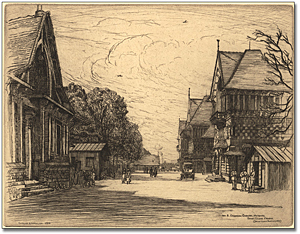
Click to see a larger image (270K)
No. 8 Canadian General Hospital,
Saint Cloud France, 1918
Caroline Armington
Reference Code: C 334-1-1-0-2
Archives of Ontario, I0003137
|
Canadian
General Hospital |
With no set duties the war artist could sketch whatever was around them thereby creating the myriad of images of destroyed buildings and more specifically the ruins of cathedrals and churches with their wrecked steeples and towers.
This fascination with bombed out
churches had much to do with the implied message that the German
army had no qualms about destroying religious buildings and cultural
property. In fact, to observers, it seemed that they were deliberately
setting out to lay waste to these buildings.
|
Ablain St. Nazaire |
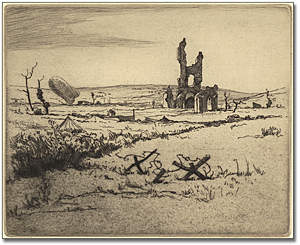
Click to see a larger image (181K)
Church ruin, Ablain, St. Nazaire, 1916
Lieut. C. H. Barraud
Reference Code: C 334-1-2-0-9
Archives of Ontario, I0003101
The other imagery that seemed
to predominate the artists' creative thoughts was the landscape
in front of them. Many images were sketched and painted that could
almost be the English countryside with very little indication that
a war was happening at all.
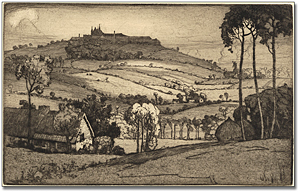
Click to see a larger image (215K)
Ruins of the Monastery, Mont
des Cats October, 1917
Lieut. C. H. Barraud
Reference Code: C 334-1-2-0-17
Archives of Ontario, I0003115
![Soldiers on the road Albert, France, [ca. 1917]](pics/3128_300.jpg)
Click to see a larger image (150K)
Soldiers on the road, Albert,
France, [ca. 1917]
Bertram Buchanan
Reference Code: C 334-1-5-0-5
Archives of Ontario, I0003128
When they did go up to the front lines they often found that during the day there was little activity with only the occasional artillery shell-exploding overhead.
It was a different story once night fell with the activity along
the front increasing as wire cutting parties moved out and supplies
were moved up. Flares burst overhead and machine gun fire would
increase as movement was detected in no-mans land.
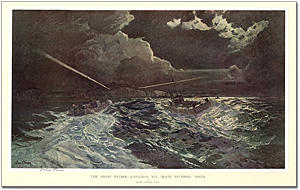
Click to see a larger image (205K)
The Night Patrol - Canadian M. L.
boats entering Dover, [ca. 1915]
After Julius Olsson, A.R.A.
Reference Code: C 334-2-0-0-7
Archives of Ontario, I0013654
![The Western Front, back lines [ca. 1915]](pics/3124_300.jpg)
Click to see a larger image (154K)
The Western front, back lines, [ca. 1915]
Alfred Bentley
Reference Code: C 334-1-5-0-12
Archives of Ontario, I0003124
|
Approaching Poperinghe on the Ypres Road |
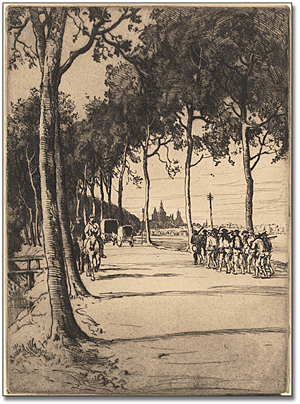
Click to see a larger image (223K)
Approaching Poperinghe, Belgium, 1917
Lieut. C. H. Barraud
Reference Code: C 334-1-2-0-8
Archives of Ontario, I0003108
|
Place St. Bertin, Poperinghe |
Place St. Bertin, Poperinghe, October 18, 1917
Lieut. C. H. Barraud
Reference Code: C 334-1-2-0-5
Archives of Ontario, I0003107
The war artists also found that when something interesting was developing it was usually quickly over, on the move or concealed by darkness. And, when a major offensive did start, they were sent to the rear and their accommodation and cars requisitioned for war purposes.
To further frustrate them, they had to work quickly as their allotted time at the front was often no more than two months and could be as short as a two or three weeks.
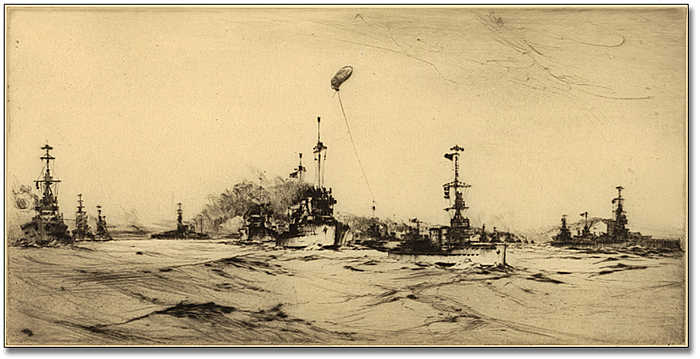
Click to see a larger image (141K)
Surrender of the German fleet, 1918
Frank H. Mason
Reference Code: C 334-1-5-0-14
Archives of Ontario, I0003117
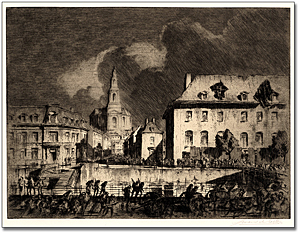
Click to see a larger image (141K)
Canadians entering Cambrai, 1918
Lieut. Gerard de Witt
Reference Code: C 334-1-3-0-2
Archives of Ontario, I0013638
|
Canadians Entering Cambrai |
In August, 1918 the Battle of Amiens began followed by the start of what is known as Canada’s Hundred Days march.
By November 10, 1918 the Canadians had reached the outskirts of Mons where in 1914 the British and French had their first major encounter with the German army that was intent on marching on Paris.
At Mons on Nov 11, 1918 at 10.58am Private George Price of the 28th Battalion was killed by a sniper. Two minutes later at 11.00am the armistice came into effect. The war was over.
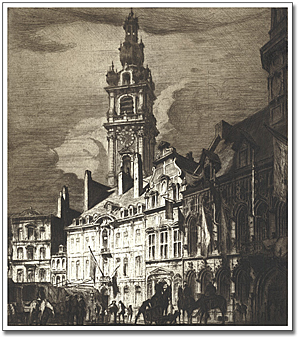
Click to see a larger image (203K)
Canadians Entering Le Grand Place, Mons, 1918
Lieu. Gerard de Witt
Reference Code: C 334-1-3-0-1
Archives of Ontario, I0013635
War Artists from the First World War | The Canadian War Memorials Fund
The Burlington House Exhibit | The Battlegrounds | The Home Front
War Artists at Work | Resources
